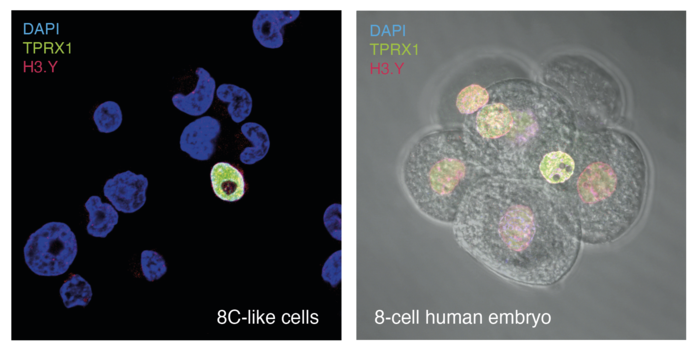Researchers from the Babraham Institute have today published their latest work in the journal Cell Stem Cell describing a new subset of human embryonic stem cells that closely resemble the cells present at the genomic ‘wake up call’ of the 8-cell embryo stage in humans. This new stem cell model will allow researchers to map out the key genomic changes during early development, and help move towards a better understanding of the implications of genome activation errors in developmental disorders and embryo loss.

Credit: Dr. Jasmin Taubenschmid-Stowers Babraham Institute, Dr. Fátima Santos Babraham Institute, Dr. Jennifer Nichols, Cambridge University
Researchers from the Babraham Institute have today published their latest work in the journal Cell Stem Cell describing a new subset of human embryonic stem cells that closely resemble the cells present at the genomic ‘wake up call’ of the 8-cell embryo stage in humans. This new stem cell model will allow researchers to map out the key genomic changes during early development, and help move towards a better understanding of the implications of genome activation errors in developmental disorders and embryo loss.
In all mammals, the early embryo undergoes a number of molecular events just after fertilisation that set the stage for the rest of development. During this key ‘wake up call’ the genome of the embryo takes over control of the cell’s activities from the maternal genome. In humans, this happens at the 8-cell stage and is called zygotic genome activation (ZGA).
Before the findings of this study, investigating the details of human ZGA could only be done in human embryos; existing human stem cell models represented the embryo only at later stages of the developmental process. In the UK, experiments using embryos are permitted but highly regulated, meaning that research into early development relied in part on alternative, non-human models.
In 2012, cells representing the genome activation stage of development were found in mouse embryonic stem cells (ESCs), allowing researchers to learn more about mammalian ZGA. Almost a decade later, the Reik lab at the Institute have found a human equivalent. The lab’s discovery opens up a way to advance our knowledge of the earliest events during preimplantation development.
Dr Jasmin Taubenschmid-Stowers, lead author and Research Fellow in the Reik lab, part of the Institute’s Epigenetics research programme , commented: “Studying mouse embryonic stem cells has allowed researchers to learn about the general process of genome activation, but we could learn even more about this important step in human development thanks to our discovery of a human stem cell counterpart.”
In order to function, cells take copies of the genome in the form of an RNA code which is translated into proteins. The RNA code output is called the transcriptome and it can be used to identify different populations of cells. In this study, researchers used existing human data sets and information from mouse ESC studies to identify characteristic transcriptome marks that could be linked to genome activation. Using single cell techniques, they started the search for similar cells in their population of human ESCs.
The team found a subset of human ESCs with the right transcriptome marks to be a potential match for the 8-cell stage, when the major wave of genome activation occurs. They called these cells ‘8-cell like cells’ or 8CLCs and used the published human data to further validate and confirm that these cells shared the same molecular outputs indicative of genome activation and could be pursued as a reliable model for future studies.
To further explore the extent of the similarities between their 8CLCs and 8-cell stage in human embryos, the team worked with Professor Jennifer Nichols from the Wellcome – MRC Cambridge Stem Cell Institute. Together they were able to select and search for proteins present in both sets of cells that were indicative of ZGA. Their results showed that the ZGA-associated proteins of 8CLCs closely matched those seen in human 8-cell embryos.
As Jasmin explains: “The collaboration with Professor Nichols and her team was vital as we could identify selected proteins and really look at those in real, fixed human 8-cell stage embryo cells compared to our new stem cell counterparts. This work confirmed that our 8C-like cells matched at the protein level too, in additional to the transcriptomics data, providing validation that the 8-cell like cells matched embryo cells across multiple molecular layers.”
“Our focus is now to characterise these cells and understand their unique properties so that we can use 8-cell like cells as a tool to ask questions about the molecular changes that may cause developmental issues at this early stage.” said Professor Wolf Reik, Babraham Institute group leader.
Journal
Cell Stem Cell
DOI
10.1016/j.stem.2022.01.014
Method of Research
Experimental study
Subject of Research
Cells
Article Title
8C-like cells capture the human zygotic genome activation program in vitro
Article Publication Date
24-Feb-2022




